Please Take Note: This is a review of the final game, but it might change slightly based on the success of the Kickstarter campaign. The game is being reviewed on the components and the rules provided with the understanding that “what you see is not what you might get” when the game is published. If you like what you read and want to learn more, we encourage you to visit the game’s website or visit the Kickstarter campaign. Now that we have all that disclaimer junk out of the way, on with the review.
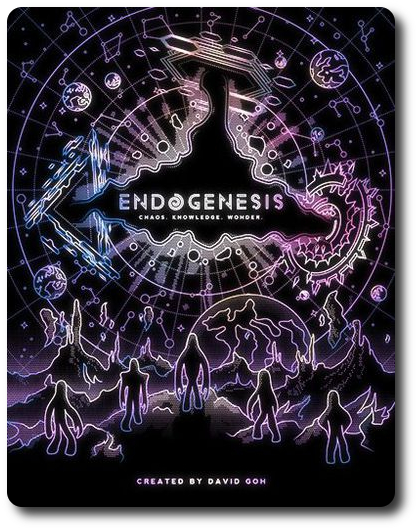
The Basics:
- For ages 10 and up
- For 3 to 5 players
- Variable game length (approximately 20 minutes per player)
Geek Skills:
- Active Listening & Communication
- Counting & Math
- Logical & Critical Decision Making
- Reading
- Strategy & Tactics
- Hand/Resource Management
Learning Curve:
- Child – Easy
- Adult – Easy
Theme & Narrative:
- Ascend and rule it all
Endorsements:
- Gamer Geek rejected!
- Parent Geek mixed!
- Child Geek approved!
Overview
You were one of the first. You saw the dawn of creation and have drifted among the stars for eons. You were content to simply observe and learn, but then something changed. You got bored. The more you knew, the more you started to feel you were missing something. Curious, you began visiting new realms and realities. You became stronger. Curiosity was replaced by greed and you became hungry for power. Now you fight for domination over all forms of reality, no longer content to simply watch. You want to rule.
Endogenesis, designed and to be self-published by David Goh, will reportedly be comprised of 1 game board, 5 Player cards, 100 Shard tokens, 6 Health markers, 6 Max Health markers, 16 Prism tokens, 30 Basic Skill cards, 10 Ultimate Skill cards, 18 Artifact cards, 15 Monster cards, 9 Legendary Monster cards, 9 Event cards, 3 Distortion cards, 12 Wonder cards, 5 Class cards, and 2 bags. As this is a review of a republished game, I cannot comment on the game component quality. The only artwork of note can be found on the cards. Artists David Goh and Yang Shao Xuan have made each card visually interesting, showing the “thing” the card is representing, making the game slightly less abstract.
Game Set Up
To set up the game, first place the game board in the middle of the game playing area and give each player one Player card, one Health marker, one Max Health marker, and three Shard tokens. Have each player place their Player card in front of them. Both the Max Health and Health markers are placed on the “3” space found on the Player card.
Second, place all the Shard tokens in a bag and then place the bag on the designated space found on the game board. Place a Max Health and a Health marker on the Monster Health track on the designated game board space. The markers can be placed on any value at the start of the game. Cards drawn and played will indicate what values the markers should be changed to.
Third, shuffle the “Realm of Knowledge” cards (which is comprised of the Skill, Ultimate Skill, and Artifact cards) and deal to each player four cards, face-down. Each player should now look at their cards and can discard any cards in their hand for an equal number of cards dealt back. This can only be done once and during game set up. Shuffle back into the deck any cards discarded and place the deck face-down on the designated game board space.
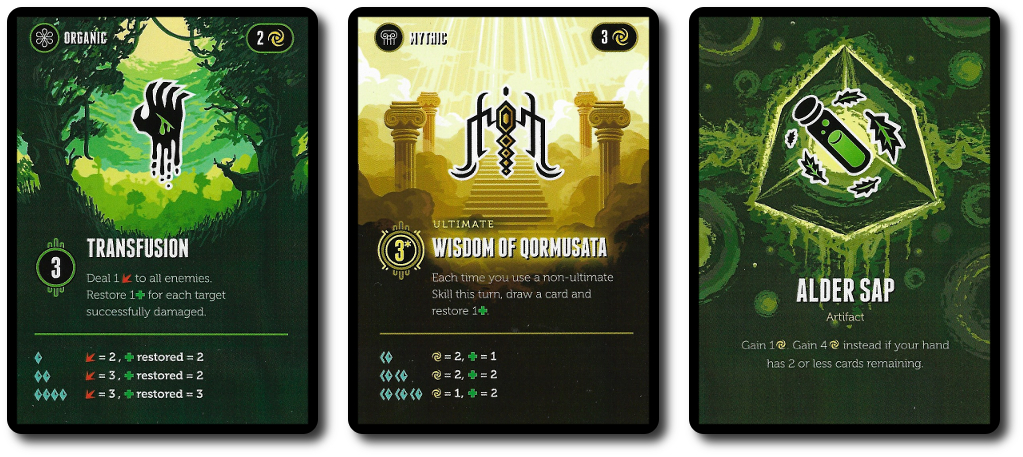
Fourth, shuffle the “Realm of Chaos” cards (which is comprised of the Monster, Legendary Monster, Event, and Distortion cards) and place the deck face-down on the designated game board space.
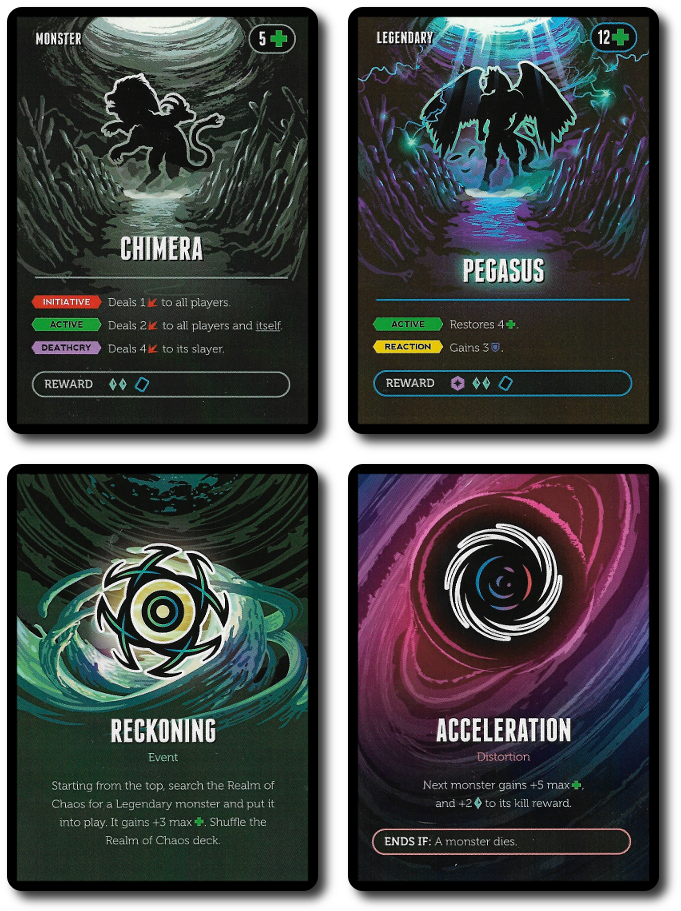
Fifth, shuffle the “Realm of Wonder” cards and place on the game board.
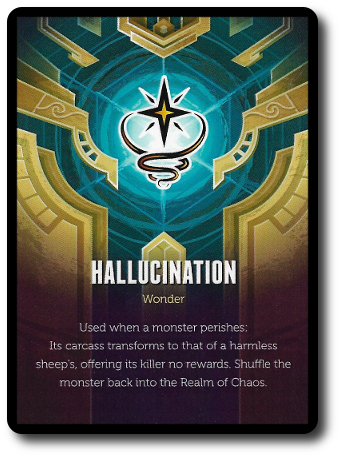
Sixth, take the Class cards and place on the game board.
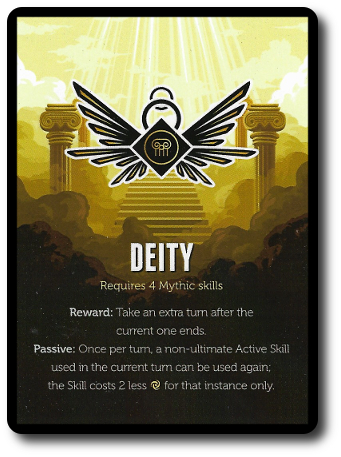
That’s it for game setup. Determine who will be the first player and give the last player one extra Shard token. Give the second to last player one extra “Realm of Knowledge” card. This card cannot be discarded for a new card.
The players have everything they need to play, but they cannot jump into the game yet…
Customize Characters
Each player was dealt a random hand of cards during game set up. Now the players will use those cards to customize their character in the game by equipping the cards they have in their hand.
Equip Skills
Skill and Ultimate Skill cards represent both active and reactionary special abilities the player’s character has at their disposal. Players place these cards in a row in front of them, with the active skills placed face-up and the reaction skills placed face-down. Ultimate Skills are more powerful than the basic Skill cards and are also limited. A player can have a maximum of three Skill cards and one Ultimate Skill card “equipped” (in play) in front of them. In addition, any Ultimate Skill can only be equipped if the player has three Skills equipped. Any cards not equipped remain in the player’s hand.
Improving Health
Once the cards are placed, players now spend their Shard tokens (if they like) to upgrade the played Skills and their character’s Health. Skills are upgraded by placing the number of needed Shard tokens by it (representing what was spent). Shard tokens spent on improving the character’s Health value are returned to the bag found on the game board. For every Shard token spent, the Max Health and Health tokens are moved to the next higher value space on the Player card. Upgrading the health values to “10” costs one Shard token per space, but any value past “10” will cost the player two Shard tokens per space. Each time a player obtains “5”, “10” and “15” Max Health, the player draws one “Realm of Wonder” card, adding it to their hand.
After each player has completed their character customization, the game can begin.
Playing the Game
Endogenesis is played in rounds and turns with no set number of rounds per game. Each player in the game will be given one turn per round, with the last turn in the round belonging to the game’s monsters. A player’s turn and the monster’s turn are summarized here.
Note: When it’s the player’s turn, they are considered “active”. The active player is the only one who can use face-up active Skill and Ultimate skill cards. All other players are considered “inactive” and can use their Skill and Ultimate skill cards that are in play and face-down to react to in-game situations if applicable. Players always have a choice if they want to use their cards or not. The Monster’s don’t, always resolving any effects noted when they become applicable.
Player’s Turn
The first thing the player does on their turn is draw one card from the Realm of Chaos and resolve it.
- Event cards are read out loud, resolved, and discarded. The player then draws another Realm of Chaos card.
- Distortion cards are read out loud and then placed face-up on the designated spot on the game board. Distortion cards represent ongoing in-game effects. They are always considered “active” until the effects of the Distortion card are removed.
- Monster cards are read out loud and the Monster Health track is adjusted according to what is stated on the Monster card.
The second thing the player does on their turn is draw two Realm of Knowledge cards, adding them into their hand.
The third thing the player does on their turn is decide what action (if any) they want to take.
- The player can equip any Skill and Ultimate skills in their hand (with the previously noted limitations in play). Any card previously played can be discarded to make room for a new card.
- The player can spend “Energy” to use any skill in front of them (active or reactive, per the card’s rules). Cards in the player’s hand can be discarded to create Energy (the amount of Energy earned is shown on the card).
- The player can play a special Artifact card to gain a class (per the class requirements).
- The player can upgrade their active character by spending Shard tokens (improving skills and increasing their health in the same way they earlier customized their character).
- The player can play a Wonder card at this time if they want to.
Whenever a Monster or a character takes damage, the health lost and the current health value is adjusted both on the Player card and on the game board using the Health and Max Health tokens. If the Monster is killed (health drops to zero), the player collects the reward noted on the Monster card. When players attack each others characters, the surviving character is awarded one Shard token and the losing (dead) character’s player loses a turn. If a card has a Bounty, the listed reward goes to the player who delivers the killing blow.
Normally, the active player is the one to deliver damage and the possible killing blow. However, inactive players can use their face-down Skill and Ultimate Skill cards to react to attacks. It’s completely possible for an inactive player to kick butt, as a result. While inactive players cannot initiate combat, they may most certainly can hold their own in a fight if they have the right cards in play.
Killing a Monster or if a Monster escapes temporarily suspends the player’s turn, meaning no additional actions can take place. Instead, the player draws Realm of Chaos cards until another Monster card is drawn. Then the player resumes their turn and can again take actions.
Killing a player character is a bit different. The “penalty of death” is determined by how many Prism tokens the player has collected.
- Zero Prisms: Discard one Realm of Knowledge card. On the player’s next turn, their health is restored.
- One Prism: The player cannot take any actions on their next turn, but they can still draw cards, reviving to full health.
- Two Prisms: Discard one Realm of knowledge card. The player cannot take any actions on their next turn, but they can still draw cards, reviving to full health.
At anytime during the player’s turn they can elect to end it. The player announces their turn is over and must discard down to seven cards in their hand. Wonder cards do not count towards the player’s hand size limit. The next player then takes their turn. This continues until all the player’s have had one turn in the round. Then the Monsters take their revenge…
Monster’s Turn
The current Monster in play is now resolved. Any active abilities listed on the Monster card are read out loud and resolved immediately. If none is listed, no actions are taken.
Winning the Game
The game continues as noted above, with players taking turns beating up each other and the poor monsters who happen to stumble into the fray. The first player to earn three Prisms (which can only be obtained by slaying a legendary Monster) wins the game. Game length can be shorted by making the victory condition two Prisms instead of three, but this should be decided before the game starts (obviously).
To learn more about Endogenesis, visit the game’s website or visit the Kickstarter campaign.
Final Word
 There is a bit of a learning curve here and the Child Geeks spent the first game learning as they played. This slowed things down, but the more advanced Child Geeks understood the game perfectly by the time the first game ended. The younger and less experienced Child Geeks took longer. Regardless, both groups enjoyed themselves. According to one Child Geek, “I think I’m playing as a god or a super monster. Not sure. But I do know that I like playing the game.” Another Child Geek said, “I had a hard time understanding why I was doing anything in the game, but I enjoyed playing it.” The game is rather abstract and the cards do nothing to tell a story. The cards are just actions and encounters. This felt a bit confusing to the Child Geeks who often attach themselves to the game’s narrative to assist in the understanding why actions are taking place. Despite the abstract nature of the game, the Child Geeks agreed that they enjoyed playing it.
There is a bit of a learning curve here and the Child Geeks spent the first game learning as they played. This slowed things down, but the more advanced Child Geeks understood the game perfectly by the time the first game ended. The younger and less experienced Child Geeks took longer. Regardless, both groups enjoyed themselves. According to one Child Geek, “I think I’m playing as a god or a super monster. Not sure. But I do know that I like playing the game.” Another Child Geek said, “I had a hard time understanding why I was doing anything in the game, but I enjoyed playing it.” The game is rather abstract and the cards do nothing to tell a story. The cards are just actions and encounters. This felt a bit confusing to the Child Geeks who often attach themselves to the game’s narrative to assist in the understanding why actions are taking place. Despite the abstract nature of the game, the Child Geeks agreed that they enjoyed playing it.
 The Parent Geeks had no problem learning the game and played it like champs. It was clear that the more casual players understood what the game was all about, but their love for it was limited. According to one such Parent Geek, “I enjoyed the game, but it was just a little too out there for me. I guess I like games where there is more of a story or the reason why I am playing it is more obvious.” And by “why”, the Parent Geek is talking about the same abstract nature of the game that caused the Child Geeks to ponder what was going on in the game’s narrative. The more advanced Parent Geeks didn’t seem to mind, however. As one Parent Geek put it, “I like games like this. They get to the point, make sure the player has a lot to think about, and gives them total control.” Control, yes. Total? Questionable. The cards allow for a lot of actions and the players can determine how they are used, but the player has little control over what cards they have (due to random draws). Which didn’t’ seem to matter as the Parent Geeks. The final vote showed that this group gave Endogenesis a mixed endorsement.
The Parent Geeks had no problem learning the game and played it like champs. It was clear that the more casual players understood what the game was all about, but their love for it was limited. According to one such Parent Geek, “I enjoyed the game, but it was just a little too out there for me. I guess I like games where there is more of a story or the reason why I am playing it is more obvious.” And by “why”, the Parent Geek is talking about the same abstract nature of the game that caused the Child Geeks to ponder what was going on in the game’s narrative. The more advanced Parent Geeks didn’t seem to mind, however. As one Parent Geek put it, “I like games like this. They get to the point, make sure the player has a lot to think about, and gives them total control.” Control, yes. Total? Questionable. The cards allow for a lot of actions and the players can determine how they are used, but the player has little control over what cards they have (due to random draws). Which didn’t’ seem to matter as the Parent Geeks. The final vote showed that this group gave Endogenesis a mixed endorsement.
 The Gamer Geeks liked some of the game’s concepts but found the game overall to be forgettable. According to one Gamer Geek, “Some great ideas here, but it feels a little like the game designer threw in everything they liked and just made it work rather than trying to pin the game down.” When I asked for more details, the Gamer Geek made it clear that the game worked, but he never felt like the “rubber met the road” when it came to the game playing experience. Another Gamer Geek said it better when they stated, “This is a great example of a game that has some good ideas but is still deciding how it wants to tell a story the players.” Again, we see the abstract nature of the game. In this case, however, instead of confusing the Gamer Geeks (as it did the Child and Parent Geeks), it caused the Gamer Geeks to feel that the game was missing a bit of its soul and purpose. This resulted in the Gamer Geeks rejecting Endogenesis. Not because it was a bad game, but because the game left them with more questions rather than answers.
The Gamer Geeks liked some of the game’s concepts but found the game overall to be forgettable. According to one Gamer Geek, “Some great ideas here, but it feels a little like the game designer threw in everything they liked and just made it work rather than trying to pin the game down.” When I asked for more details, the Gamer Geek made it clear that the game worked, but he never felt like the “rubber met the road” when it came to the game playing experience. Another Gamer Geek said it better when they stated, “This is a great example of a game that has some good ideas but is still deciding how it wants to tell a story the players.” Again, we see the abstract nature of the game. In this case, however, instead of confusing the Gamer Geeks (as it did the Child and Parent Geeks), it caused the Gamer Geeks to feel that the game was missing a bit of its soul and purpose. This resulted in the Gamer Geeks rejecting Endogenesis. Not because it was a bad game, but because the game left them with more questions rather than answers.
 “Why does this game even exist?” was one of the questions I was asked during our game playing sessions. The person asking it wasn’t being rude, but was asking a genuine question on the game’s purpose. There appears to be a story that should support the game, but there is none. This left the players feeling they were playing a game that didn’t have a purpose other than just being a game with cards that did things. Our players have experienced and enjoyed many abstract games in the past and the more abstract they are, the more the player feels like they are just moving pieces to meet an objective rather than becoming part of a story being told by the game through the game play.
“Why does this game even exist?” was one of the questions I was asked during our game playing sessions. The person asking it wasn’t being rude, but was asking a genuine question on the game’s purpose. There appears to be a story that should support the game, but there is none. This left the players feeling they were playing a game that didn’t have a purpose other than just being a game with cards that did things. Our players have experienced and enjoyed many abstract games in the past and the more abstract they are, the more the player feels like they are just moving pieces to meet an objective rather than becoming part of a story being told by the game through the game play.
But Endogenesis was different and made some of our players rather passionate in their response. I believe this is because there is a story in Endogenesis, but it’s not jumping out to the players. Each individual is a super uber god, representing something of immense power that cannot be described. Which, in turn, makes their entire reason to play the game as this super powerful “thing” important but never explained. How to win the game is obvious, but why you want to is not clear. This makes the players think there is a disconnect.
Putting that aside and just focusing in on the game and none of the players had any concerns. Endogenesis is well designed and is interesting to play. Rules are good, card interaction is both strategic and tactical, and there is a lot for a player to consider and do. Mechanically, Endogenesis is good stuff. Thematically, not so much.
So, it comes down to this: theme and narrative versus mechanics and game play. Normally these two are in sync, with one supporting the other. Defining and driving the player’s actions. Endogenesis is missing this coupling and players felt the game was a bit off the mark as a result. Give the game a try and see if story trumps game play or vice versa. If you are looking for a game that makes you think, Endogenesis will fit the bill nicely.
This is a paid for review of the game’s final prototype. Although our time and focus was financially compensated, our words are our own. We’d need at least 10 million dollars before we started saying what other people wanted. Such is the statuesque and legendary integrity of Father Geek which cannot be bought except by those who own their own private islands and small countries.



